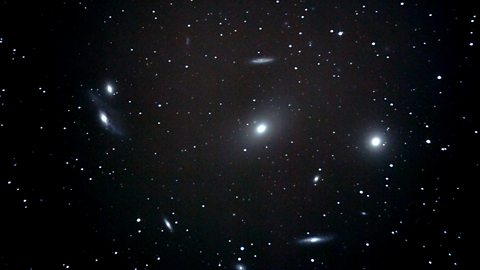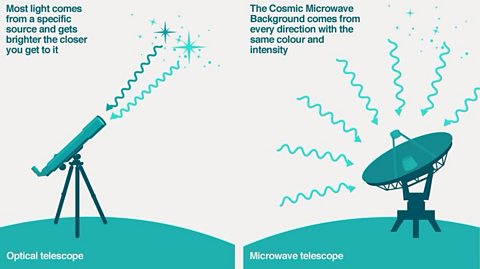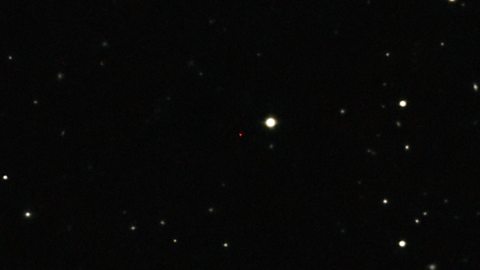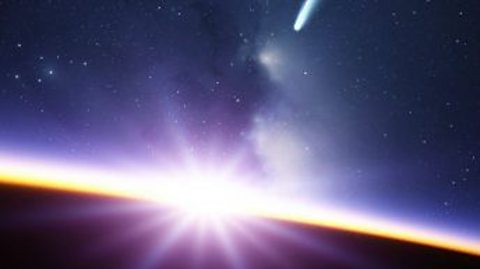HOW DO WE KNOW THE BIG BANG ACTUALLY HAPPENED?
Introduction with Maggie Aderin-Pocock
People talk about the universe starting with a Big Bang, but how could we possibly know anything about an event that happened billions of years ago – before our planet was even formed?
Even if the birth of the universe came out of the most violent expansion, then could it be possible that evidence of the Big Bang still resounds today?
Such was the force of that expansion that maybe there is evidence of that tremendous energy that we can still detect.
As light takes millions of years to travel the vast distances of the universe, looking out into space is a bit like looking back in time. Could that tell us what the universe was like just after the Big Bang?
By observing how galaxies are moving away from us, we might be able to work out where they came from. Could that tell us that everything started from a single point? So is it possible to know whether the Big Bang actually happened?
Where did we come from?
It’s the oldest question in human history. Everyone’s asked it, from philosophers and poets to mathematicians and physicists.
Most scientists think that everything that we know and experience around us began at a moment known as the Big Bang, 14 billion years ago. But how can we have any clue about something that supposedly happened so long ago?
From speeding galaxies to ancient gas clouds, there is evidence that we can detect today – the remnants of the Big Bang, that tell a clear story about the origins of our Universe.

We can see the universe expanding
When we look at the night sky, the stars we can see are within our own galaxy. But there are also some fuzzy patches. These are other galaxies like our own – but they are much, much further away than the stars.
Almost all of these galaxies are moving away from us – some at speeds of hundreds of thousands of kilometres every second.
If most galaxies are moving away from us, it means that the Universe is expanding. If the Universe is expanding, then in the past it must have been much smaller. Go back far enough, and there was a moment when all the matter in the Universe was packed into a point and expanded outwards. That moment was the Big Bang.
We can even work out when it happened from the speed of the galaxies: about 14 billion years ago. We can't actually see the galaxies moving, but the clue is in the light coming from them – it is redder than it should be.

Why galaxies look redder than they should
The tell-tale signature of a galaxy speeding away from us can be detected in the same way that we can tell when a police car passes us with its siren on. When that happens, the siren sounds lower pitched to us, because the waves are stretched.
Light is also made up of waves, so the same is true of very fast-moving objects like galaxies. If a galaxy is moving away from us, the light waves are stretched. That makes the light seem redder. The faster the galaxy is moving, the redder the light.

Capturing the afterglow of the Big Bang
We can't see it with the naked eye, but some of our telescopes can.
Our eyes actually only see a fraction of the light in the Universe. As well as visible light, there are other kinds of light, such as X-rays, infrared light, ultraviolet light, radio waves and microwaves. They have shorter or longer wavelengths than visible light.
After the Big Bang, the whole Universe was flooded with incredibly bright light. As the Universe has expanded, that light has stretched into microwaves.
A microwave telescope can see this ancient light from the very beginning of the Universe. In fact, a view through a microwave telescope shows the whole sky filled with a glow, day and night. This glow is called the Cosmic Microwave Background.
Maggie Aderin-Pocock explains that ripples in the Cosmic Microwave Background hint at the starting conditions that seeded stars and galaxies. Image: ESA/Planck.
Capturing the afterglow of the Big Bang
MAGGIE ADERIN-POCOCK:
This is one of the most detailed pictures ever taken of the entire night sky. You can see the band of the Milky Way running all the way across.
There’s a bright patch at the centre, which is the middle of our galaxy. Because light takes time to travel through the vast distances of space, we’re looking at our galaxy as it was 27 thousand years ago. But what if we could peer even further back in time? What would the universe look like then?
In 1964, Arno Penzias and Robert Wilson did exactly that. And they did it by accident. Penzias and Wilson were trying to study space by looking at microwaves rather than visible light. While testing their equipment, they noticed a constant signal that was the same inwhatever direction they looked. Where could this signal be coming from?
If it came from our own galaxy, it would be stronger in some directions than in others. Beyond our own galaxy the universe is clustered into galaxies with empty space between. So a signal that came from somewhere in particular would vary in strength depending on where the sensors were pointing.
Penzias and Wilson thought that the signal could have come from a time when all the matter in the universe was spread evenly through space.
This indicated that the universe had once looked very different from today: The first strong evidence that the universe had begun with a Big Bang. But the story doesn’t end there. Astronomers realised that to learn more about this background microwave radiation, they would have to go to space.
In 1992, the Cosmic Background Explorer showed that Penzias and Wilson’s signal wasn’t quite as uniform as we thought.
The data it gathered were just as surprising as the original signal. They showed that the early universe wasn’t entirely uniform after all. And while these ripples are tiny, they might suggest reasons why matter is clumped together the way it is today. They hint at the starting conditions which seeded the stars and the galaxies, which we all know now so well.
In 2013, ESA’s Plank Telescope made the most accurate map of the universe yet. And it revealed a strange asymmetry in the background radiation. Astronomers still don’t know what caused this. And while the new pictures don’t challenge the Big Bang theory, they do mean there’s still plenty left to explain about how the universe came to be the way it is today.
Images (in order of appearance):
- Image of the deep sky. Credit: Axel Mellinger
- Image of Arno Penzias and Robert Wilson. Credit: Emilio Segre Visual Archives/American Institute of Physics/Science Photo Library
- Image of ECHO horn antenna. Credit: NASA/Science Photo Library
- Image of Messier 81. Credit: Adrian Jones, courtesy of the В鶹№ЩНшКЧТіИлїЪ The Sky At Night Flickr group:
- Image of the Horsehead and Flame Nebulae. Credit: Terry Hancock, courtesy of the В鶹№ЩНшКЧТіИлїЪ The Sky At Night Flickr group:
- Diagram and images of the Cosmic Background Explorer by NASA
- First “baby picture” of the universe. Credit: NASA
- Artist’s impression of the Planck spacecraft. Credit: ESA - C. Carreau
- Image of Planck enhanced anomalies. Credit: ESA and the Planck Collaboration
- Image of the night sky. Credit: DC, courtesy of the В鶹№ЩНшКЧТіИлїЪ The Sky At Night Flickr group:
How starlight differs from microwaves
Unlike the light coming from a star, the Cosmic Microwave Background is the same wherever you look, and wherever you are in space.


We can peer back in time
Looking out into space is like looking back in time. That is because light from objects that are far away takes longer to reach us than light from objects nearby. If an object is a million light years away, we are seeing it as it looked a million years ago.
Modern telescopes are so powerful that they can view objects many billions of light years away, close to the time of the Big Bang. If the Big Bang did happen, then we'd expect those distant views to reveal clouds of gas which have not yet turned into stars and galaxies.
Astronomers have recently found gas clouds like this in the distant Universe. Some of them are around 12 or 13 billion years old. Even at this incredible distance, we can tell what they are made of by using a technique called spectroscopy to analyse light that passes through them.
As Big Bang theory predicts, these ancient gas clouds are made of very different stuff to the modern Universe. Most of the chemical elements in the modern Universe are made inside stars. Because the gas clouds come from a time before stars, they consist almost entirely of the most basic elements, hydrogen and helium.

Learn more about this topic:
How will the Universe end? document
Dr Aravind Vijayaraghavan reveals how the second law of thermodynamics explains the rise and fall of all things, including the Universe itself.

Did comets kick start life on Earth? document
Life, as we know it, cannot exist without water and organic molecules – the building blocks for all living creatures. Find out if comets brought these to Earth.

Does Einstein’s general theory of relativity still matter? document
Over 100 years ago Einstein first described his general theory of relativity. This theory had a profound effect on physics and our understanding of the universe. But does it still matter today?
